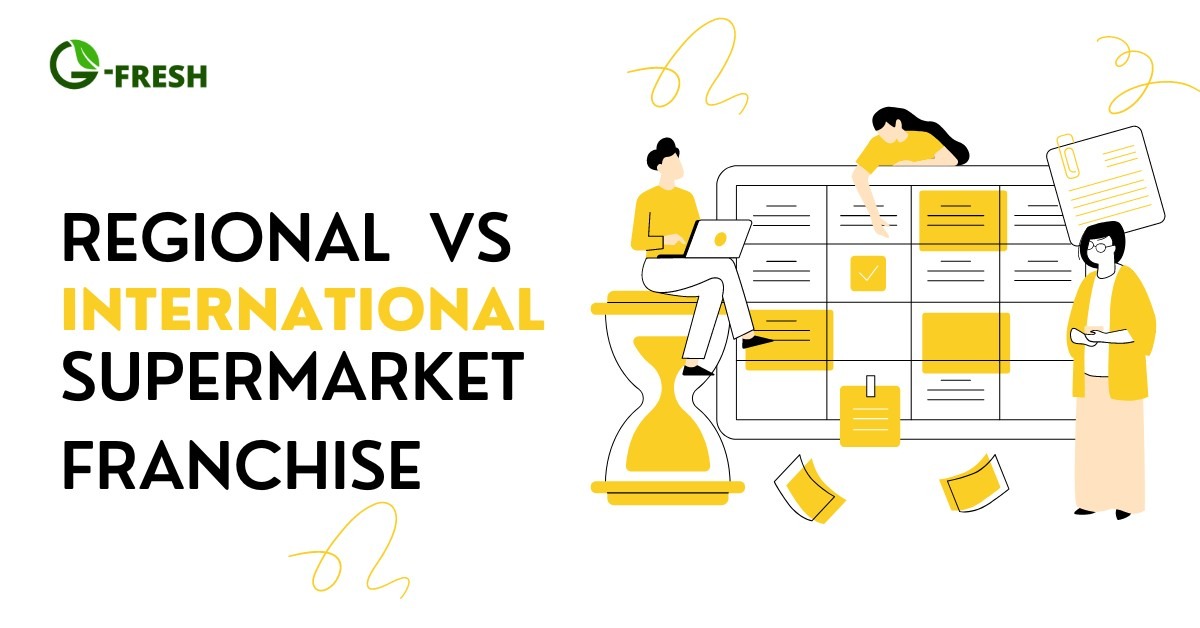Compare The Business Models And Strategies Of Regional Vs. International Supermarket Franchises
Compare the business models and strategies
In the world of retail, supermarkets are a crucial part of everyday life. They provide a wide range of products, from fresh produce to household essentials. When examining supermarkets, one can broadly categorize them into regional and international franchises. These two types of supermarket chains operate under different business models and strategies. This blog aims to explore and compare the business models and strategies of regional vs international supermarket franchises, shedding light on how each operates and thrives in its respective market.
Discussing Regional Supermarket Franchises
Regional supermarket franchises are supermarkets that primarily operate within a specific geographical area or region. These supermarkets are often tailored to the local tastes, preferences, and needs of the community they serve.
Key Characteristics of Regional Supermarkets
- Localized Products and Services: Regional supermarkets focus on catering to local tastes. They stock products that are popular within their area, often featuring local produce and regional specialties.
- Community Engagement: These supermarkets tend to build strong relationships with their customers. They often engage in local events, sponsor community activities, and support local causes.
- Flexible Pricing: Pricing strategies in regional supermarkets can be more adaptable. They may adjust prices based on local competition, economic conditions, and customer feedback.
- Personalized Customer Experience: Regional supermarkets often provide a more personalized shopping experience. They may have knowledgeable staff who are familiar with regular customers and can offer personalized recommendations.
- Store Size and Layout: Typically, regional supermarkets are smaller in size compared to their international counterparts. The store layout is designed to maximize convenience for local shoppers.
- Supply Chain and Logistics: The supply chain for regional supermarkets is usually shorter and simpler. They often source products from local suppliers and farmers, which helps in reducing transportation costs and ensures fresher products.

International supermarket franchises, on the other hand, operate across multiple countries and continents. These chains aim to provide a consistent shopping experience regardless of location.
Key Characteristics of International Supermarkets:
- Standardized Products and Services: International supermarket chains strive to maintain uniformity across all their locations. They offer a standardized range of products, often including global brands and internationally recognized items.
- Global Branding: These supermarkets invest heavily in creating a strong global brand. Their branding is consistent across different countries, which helps in establishing a recognizable identity worldwide.
- Economies of Scale: By operating on a larger scale, international supermarkets benefit from economies of scale. They can negotiate better prices with suppliers, which allows them to offer competitive pricing and special promotions.
- Advanced Technology: International franchises often incorporate advanced technology in their operations. This includes sophisticated inventory management systems, self-checkout kiosks, and data analytics to understand and predict customer behavior.
- Uniform Store Layout: The layout and design of stores are typically consistent across various countries. This uniformity helps in creating a familiar shopping environment for customers, regardless of where they are.
- Complex Supply Chain: International supermarkets manage a more complex supply chain. They source products from a wide range of suppliers globally and must navigate different regulatory environments in each country they operate.
Comparing Business Models and Strategies
When examining the business models and strategies of regional versus international supermarket franchises, it’s essential to understand how these entities adapt to their unique market environments. Regional supermarket franchises often thrive on a deep understanding of local tastes and preferences, allowing them to tailor their product offerings and store formats to fit community needs. Their success usually hinges on local supply chains and personalized customer service, creating a strong connection with their target audience.
In contrast, international supermarket franchises face the challenge of operating across diverse cultural and economic landscapes. Their strategies typically involve standardizing certain elements to maintain brand consistency while adapting others to align with local market conditions. This balancing act allows them to leverage economies of scale and global procurement efficiencies, but also requires sophisticated market research and flexible operational strategies.
Comparing these approaches reveals how supermarket franchises navigate their respective landscapes, regional players focusing on localized success and customer intimacy, while international chains aim for global reach with strategic localization. Understanding these dynamics provides insight into how supermarkets align their business models with their operational contexts to achieve growth and sustainability.
-
Market Focus and Customer Engagement
- Regional Supermarkets: Their primary focus is on the local market. They engage deeply with the community and tailor their offerings to match local preferences. This localized approach helps them build strong customer loyalty and adapt quickly to changes in consumer preferences.
- International Supermarkets: These chains focus on maintaining a consistent global brand and experience. While they do adapt to local tastes to some extent, their primary strategy is to offer a standardized shopping experience. They leverage their global reach to attract a diverse customer base and maintain brand recognition.
-
Pricing and Cost Management
- Regional Supermarkets: Pricing is often more flexible and competitive, reflecting local market conditions. Regional supermarkets can adjust prices based on local competition and cost fluctuations. Their smaller scale limits their ability to negotiate bulk discounts with suppliers.
- International Supermarkets: They benefit from economies of scale, allowing them to negotiate better prices and offer competitive rates across various markets. Their pricing strategy often involves a combination of low prices and high-volume sales to drive profitability.
-
Supply Chain and Inventory Management
- Regional Supermarkets: With a focus on local sourcing, regional supermarkets often have shorter supply chains. This can result in fresher products and lower transportation costs. However, their smaller scale might limit their ability to manage large inventories effectively.
- International Supermarkets: They operate with complex and extensive supply chains. They manage global sourcing, which allows for a wide range of products but can also introduce challenges related to inventory management and logistics. Advanced technology helps them maintain efficiency and reduce costs.
-
Technology and Innovation
- Regional Supermarkets: While they may adopt technology to improve operations, their focus is often on practical solutions that address immediate needs. Innovations are usually implemented at a slower pace compared to international chains.
- International Supermarkets: They invest significantly in advanced technology, including data analytics, automation, and customer-facing tech. This investment supports their large-scale operations and helps them stay competitive on a global scale.
-
Customer Experience and Store Design
- Regional Supermarkets: The shopping experience is often more personalized and community-oriented. Store designs are tailored to local preferences, and staff are generally well-acquainted with regular customers.
- International Supermarkets: The store design is standardized to provide a consistent shopping experience across locations. While the customer experience is designed to be efficient and familiar, it may lack the local personalization found in regional supermarkets.
Conclusion:
In summary, regional and international supermarket franchises operate under distinct business models and strategies, each tailored to their specific market focus. Regional supermarkets excel in local engagement, flexibility, and personalized service, while international supermarkets leverage their scale, standardization, and advanced technology to compete on a global level. Understanding these differences can offer valuable insights into how supermarkets adapt to their environments and cater to the diverse needs of their customers. Whether shopping at a local store with a community feel or a global chain with consistent quality, each type of supermarket brings unique strengths to the retail landscape.
FAQs: Comparing Regional vs. International Supermarket Franchises
- What’s the main difference between regional and international supermarket franchises?
Regional supermarket franchises focus on serving local or regional markets, tailoring their products and services to the needs and preferences of those specific areas. International supermarket franchises operate in multiple countries and often adapt their offerings to fit various international markets.
- How do regional supermarkets decide what products to stock?
Regional supermarkets usually select products based on local tastes, preferences, and buying habits. They might carry items that are popular in their specific area but not found in other regions.
- How do international supermarkets choose their product range?
International supermarkets often offer a mix of global and local products. They aim to provide a consistent experience across different countries while also including items that appeal to local customers in each market.
- What are some key strategies for regional supermarket franchises?
Regional supermarkets often focus on deep community connections, personalized service, and local sourcing. They may run promotions that resonate with local events and holidays, and they often support local businesses.
- How do international supermarket franchises operate strategically?
International franchises typically emphasize standardization for efficiency, such as uniform store layouts and product branding. They also adapt to local cultures and regulations, which can mean adjusting their product offerings and marketing strategies in different countries.
- What are the main challenges for regional supermarkets?
Regional supermarkets may face challenges like limited market size and competition from larger chains. They must also stay updated with local trends and manage supply chains effectively within their region.
- What challenges do international supermarket franchises encounter?
International supermarkets must navigate diverse regulations, cultural differences, and varying consumer preferences. Managing a global supply chain and maintaining consistent quality across countries can also be complex.
Also Read : Franchises adapt their product lines and marketing strategies
